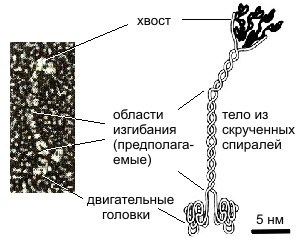Kinesin molecules are the driving proteins inherent not only in humans, but also in other living organisms. The work of this protein can be compared to the work of a small horse, which carries a vital load along the roads called microtubules.
The work of kinesin, although invisible to the naked eye, is very important for the human (as well as any other) organism. And since you need to know your heroes by sight, estet-portal.com will introduce you to this little hard worker and his working days.
Meet the protein kinesin – postman and biological robot
A standard kinesin molecule measures 70 billionths of a meter in size and is incredibly similar to a tiny human. The kinesin also has two "handles" with which it holds its burden, and two "legs" with which it "walks"; along the microtubule, dragging the cargo to its destination.

Fig. 1. Kinesin molecule
Inside all eukaryotes, i.e. life forms whose cells contain a nucleus, at a certain time and in a certain place, the delivery of proteins and other substances must be carried out. When it comes to proteins, the "manufacturer" (ribosome) receives an "order" to a protein from the nucleus (where the information is stored in DNA, but the “order” is sent in the form of an RNA copy of a specific DNA segment).
The above process is a complex and well coordinated process. Just imagine: the information must first get into the DNA of a living organism, be placed in the exact place where specific information is stored, be copied and get to the "factory". See video below.
After that, another organelle of the cell (the Golgi apparatus) packs the necessary part into a vesicle (a kind of bag) and puts a "delivery address" on it. parts on the outer shell of the vesicle.
Then the kinesin gets to work. He picks up the "package" and moves along the microtubules in the cell and delivers the cargo to the specified address. By the way, there are many types of kinesin and related proteins, the functions and features of which vary depending on the living organism.
Other duties of the kinesin protein in the human body
For one 8nm stride, kinesin uses 1 molecule of ATP (adenosine triphosphoric acid) to act as fuel. However, in addition to the above function, kinesins perform other tasks:
- Support mitosis (cell division).
- Promote meiosis (cell division in which the nucleus divides into four daughter nuclei to produce reproductive cells).
- Kinesins transport neurotransmitters (serotonin, dopamine, etc.) that help neurons communicate.
- Some kinesins are able to disassemble microtubules after passing through the path. Controlling the length of microtubules is very important, for example, during cell division, when otherwise chromosome instability (leading to cancer) occurs.
Specifications of the super-efficient kinesin protein engine
Smart kinesin not only performs a whole bunch of tasks, it also does it with incredible efficiency. The main characteristics of kinesin are given below.
- High efficiency – efficiency of the "kinesin engine"; is about 50%, which is almost twice as high as that of a gasoline engine. On a weight basis, kinesin generates about 15 times more power than a man-made engine.
- Speed – kinesin is extremely nimble – he can take 100 steps per second. If we translate this figure into the speed of a person, it would be 600 m / s or as much as 2000 km / h!
- Energy Saving – kinesins work from a universal energy source – ATP (produced by ATP synthase). As stated above, one ATP molecule is required for one 8nm kinesin stride, which hibernates if it is not carrying a load. Thus, the tiny protein does not waste ATP.
- Teamwork – kinesin molecules are able to combine to transport especially heavy loads – they seem to pass the baton to each other, having overcome a certain part of the path.
- Flexible scheduling – kinesins are also able to "bypass" obstacles in their path. The kinesins can automatically reroute when needed, as if they had built-in GPS.
- Recycling – kinesins are either transported in bulk back to the cell center, or "dismantled" and their parts are recycled during tasks.
It's amazing how precisely the mechanism of the cell's work is thought out, how just one molecule can perform all these functions! This once again proves that a person has a lot to learn from Mother Nature.






Add a comment